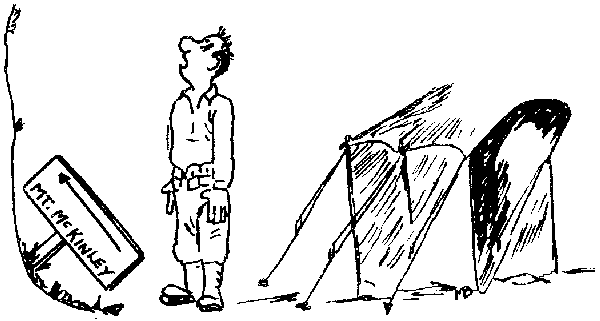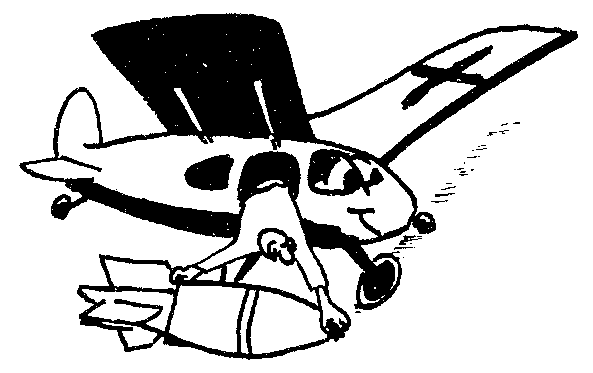| History - 49th A.I.B. - Headquarters Company |
 | Index
|
| Index
| | Next |
| Next |
|
(Pages 96-98)
 R E V E R I E S O F A 5 0 4 R E V E R I E S O F A 5 0 4
EDITOR'S NOTE: For the uninitiated a 504 in a mortar platoon is an inconspicuous individual who can only be distinguished by his rounded shoulders caused by the constant pressure of a mortar base plate and a full load of mortar shells.
England is a necessary stop on the average soldier's jaunt around the ETO, and the men of the 49th Infantry were no exception. One stormy night in the late fall of 1944 a grimy band of overseas 'rookies' were rudely dumped into an ankle deep muddy greensward in the South of Britain. They were told to make themselves at home in the dimly outlined environs of a tent city called Penning's Camp. Wet and freezing, they retired to their respective areas, with the Headquarters Company 'Stovepipers' assembling in four tents, one of which leaked noisily. With mutterings and misgivings a few hardy souls ventured out into the torrential rain and gathered fuel for the near future. Sleep did not come easily that night.
Let us skip a few spaces in the calendar and look at our surroundings:
Mud and Pyramidals (a la Tidworth) -- Mud is self-explanatory. However, pyramidal tents may need a little clarification. A P. T. is a temporary billet made of heavy tarpaulin and is usually the home of an Infantryman, to whom it surely is a luxury. Here in Merrie England the P. T. was the thing. With a heating system complete with wood and coal burning stove and no radiators, we of the Mortar Platoon were as cozy as polar bears in hibernation. The mood was primitive and the furnishings fitted the mood. A bare, pebbly floor is the best thing for one's ankles and leg muscles, so what more could the garden variety of foot-soldier ask for? (Someone said something about movement in half-tracks, but we never did believe them.) The manufacturers and designers of P. T.'s apparently never believed in the 'no squat, no stoop, no bend' slogans, and so they rigged up a lulu of an entrance to our 'canvas castles' -- it consisted of a series of opening flaps which would just as easily trip you up as not. The piece de resistance was the lighting system -- none existed. It was as simple as all that. But we of the Mortar Platoon were not dismayed. Headquarters Tent, inspired by Sergeant Mancuso took it upon themselves to make a change. The result: Wooden floor (at an angle of 10 degrees-topographical conditions, you know), clothes racks, storm door (opening inward, outward, sideward or what have you), lawn chair (grass grew up between the cracks in the floor boards), and a writing desk. It must have been good because all others tried to duplicate it.
Brooks Henrikson confided in me one day, and claimed that he should have been a diver. It seems that our boy, whenever on KP in our 'air-conditioned' mess hall, always found himself at least one fathom deep. That is, unless the water froze in the hose (rhymes doesn't it?) - and then I suppose his name might as well have been Sonia Henie.
Speaking of the mess hall it seems that most of the boys, after considerable practice (so what if you did get 60% wool and 40% cotton in your stew) mastered the art of eating with gloves on -- especially those self-made mittens belonging to Al Chizawsky.
Q. Did someone back there ask me about the mud?
A. The mud in Tidworth was the friendliest darn mud I've ever seen or slogged through. Once it formally introduced itself, it stuck to you like a leech -- and it wouldn't go away. We tried to outfox it by alternating combat boots and shoes with leggings each day, but that led only to further chaos. Boots managed to turn up on shoe days and vice versa. Maybe we should have worn skis.
Q. Did someone back there ask me about the latrines?
A latrine is army slang for the conventional bathroom. Our latrine, however, had several unique features:
1. It was approximately one-half mile away.
2. Ice-cold seats.
3. Detachable bowls (Remember the daily collectors?)
4. Complete air-conditioning with cross current gales and terrific updraft.
|
-- 96 --
|
Training classes continued in full swing at Penings. Calisthenics were a morning ritual, and Captain Potter's 'bear walk' was still a feared, but necessary exercise. Every day the Mortar Platoon would theoretically attack that model village behind Tent No.3 and our enemy was always demolished -- in fact they never returned a shot. I'm sure you can all remember 'Mt. McKinley' directly behind the latrine. By a slow count, Bob Fiedler figured that it took the fellows 20 minutes to reach the top. When, just thinking about that climb tuckers me out. On Saturday mornings, rain or shine, Lt. Kaposta would incongruously stand in the pool and G-2 us on world events. The question period after the orientation usually wound up with some character asking, 'When are we going to London again?'

Whenever one mentions London he must mention Picadilly in the same breath. The trips to London undoubtedly were dreamed up by the Special Service Officer who unwittingly was forced to travel back from a Sunday in Salisbury by truck convoy. I hear tell that after coming close to being trampled in the 11:00 PM stampede, that night, he was let off the truck and into a drainage ditch one -- quarter of a mile from his quarters. Having an inherent sense of goodness toward his fellow men, he thereafter campaigned for the London trips on behalf of the GI's. For what else could one do in Salisbury but nibble fish and chips.
London, or I should say Piccadilly, became unanimously popular, and it wasn't because of the bright lights either. They tell me that the most particular people congregated there. I have a suspicion that it was quite similar to our Wall Street -- people who were always discussing shillings and pounds.
By the way, what was your formula for beating the mob to the Hans Crescent?
Allen Jensen claims to be the only man in the Platoon to ever go on a sightseeing tour.
Herbie Boyd, 49th bandleader, had such a severe case of laryngitis that Ray Monce remarked that his (Boyd's) was 'The Voice of the Turtle'.
The Army PX Ration System was introduced to us and immediately thereafter the candy lovers, the Camel boosters, and the Raleigh haters were differentiated. A favorite indoor sport called 'I'll trade you two packs of Chelsea's for a Milky Way' soon developed. Incidentally, that ultimate goal was never achieved.
'Sump' Crump was lost for six hours one night trying to take the short cut 'over the hill' into Tidworth. Personally, I would have used a compass.
We all spent New Year's Eve in bed -- alone!
Those hectic days just prior to leaving England were also times for great decision. All T/E equipment had to be distributed in full and often times it was hard for the individual to decide on the spot whether his size 36 posterior would fit into a size 32 pair of shorts. In the army this seemingly impossible feat can usually be accomplished. All mortar crews were issued combat suits -- that is, the lower half and the hoods -- but where the h --- were the jackets!
Two or three days before leaving we replaced our candles with electricity. That is for one hour in the morning and two hours at night. It was only during those hours that we could reasonably be sure of our tent mates. Fine thing!
We of the Mortar Platoon envied the Medics newly painted helmets. They were truly colorful and they reminded one of a snappy looking football team.
|
-- 97 --

We finally said goodbye to Tidworth (after policing the area 23 times in three days), loaded into 'moving vans' in which men and material were indiscriminately piled -- and eventually reached Southampton. The docks proved to be in the next county and we embarked on a speed march with full field equipment plus duffle bags. At the end of the jaunt, adrenalin was administered and we all boarded the SS ---, a Polish ship with an English crew.
The SS --- had plenty of tables but no beds.
The favorite past-time crossing the Channel was sweating out the Canteen line. Once you foolishly got caught in it you were stuck for several hours. And what did you finally get out of it? - 'No Name Cola', and Egyptian cigarettes -- Bah!
Le Havre undoubtedly was a beautiful and modern port. After 'D'Day, however, a complete change was wrought in her. Our first view of total war took place while entering this great port. It was here that we saw our first pillboxes and took our only ride in an LCI. A few of the boys almost landed in the drink after that lofty leap from the SS --- , but they made it, nevertheless. This shell of a city acted as our hostess for only a matter of minutes, for giant Com Z trailer trucks were soon to whisk us away to parts unknown.
Our trip through Brittany was punctuated by extreme cold and the sleepy greetings of a handful of Frenchmen and women afflicted with insomnia.
The Chateau at Belleville a Coeur had formerly been headquarters for some German bigwigs, but to us it was merely a temporary haven from the elements. Its rooms must have been made of elastic, seven or eight men sleeping on a floor, comfortably accommodating three.
Exploration trips around the Chateau netted us our first bottle of 'vin', some rusty German equipment, and a few neighborhood characters. The boys also heard that the Krauts had buried many civilians in the backyard, but none bothered to investigate further.
Motor Pool guard took on a serious nature with the warning that paratroopers could land in the vicinity. Every Frenchman with blond hair and blue eyes was looked at suspiciously. Herb Shapiro thought he had one once, but he let him get away. He turned out to be an overcurious Bellevillite.
The Company was startled out of its wits one evening by the sound of small arms fire coming from the vicinity of the Motor Pool. All available men hastened to the scene, with nerves taut and weapons cocked. The 'enemy attack' turned out to be two very 'stinko' riflemen from another company, having a little after hours target practice.
We left the Chateau early one morning with all the confusion usually connected with a 'Paul Revere'. PS -- The famous sleeping bag was issued that very morning -- unopened.
Thanks to the odoriferous gas hood, and extra blankets we were able to combat the chills that went in at the boot tops and came out of the helmet liner, during that epic ride from Belleville to Rheims.
Isolated Facts Learned While Travelling Through France in the Dead of Winter:
1. Half-track M4 A1 capacity: too many.
2. The chances of a front car commander's nose getting to look like W. C. Field's: very good.
3. In order to survive, every crew-member must dash madly up and down among the vehicles during the time allotted for a break. Otherwise, circulation stops, and only an ice pick and a pair of tongs will dislodge him from his seat.
|
-- 98 --
|